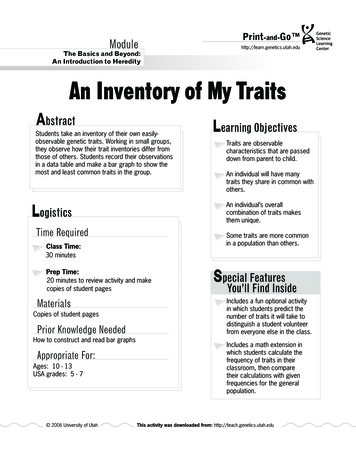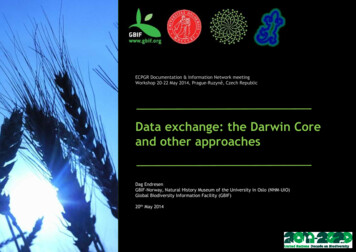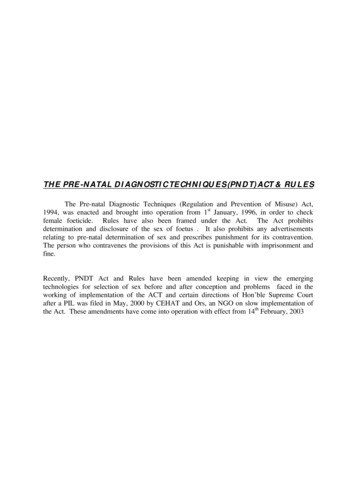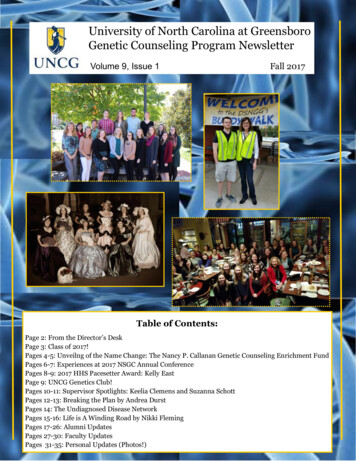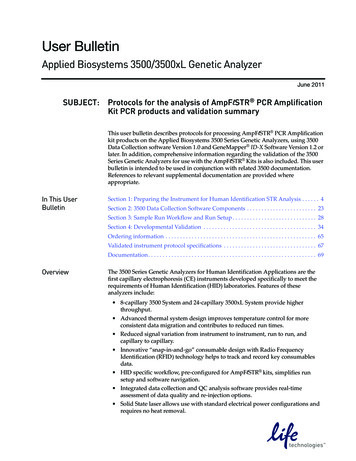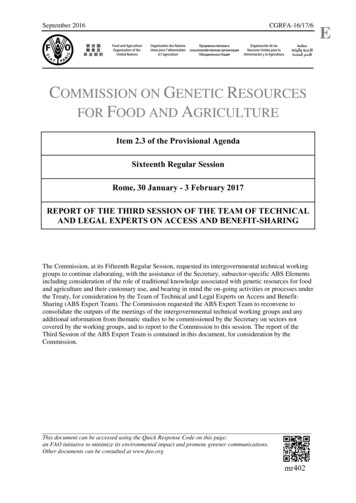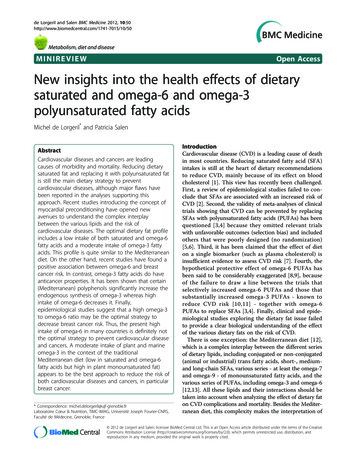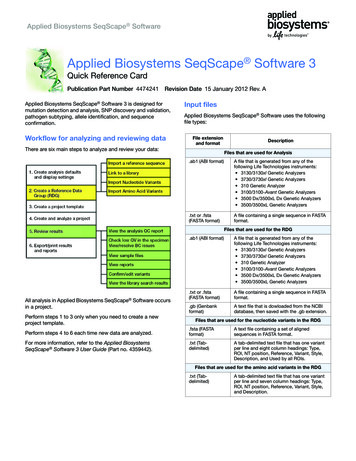
Transcription
ResearchT A O’Mara et al.ESR1 locus fine-mapping forendometrial cancer22:5851–861Endocrine-Related CancerComprehensive genetic assessmentof the ESR1 locus identifies a riskregion for endometrial cancerTracy A O’Mara1, Dylan M Glubb1, Jodie N Painter1, Timothy Cheng2, Joe Dennis3,The Australian National Endometrial Cancer Study Group (ANECS)1, John Attia4,5,Elizabeth G Holliday4,5, Mark McEvoy5, Rodney J Scott4,6,7,8, Katie Ashton4,7,8,Tony Proietto9, Geoffrey Otton9, Mitul Shah10, Shahana Ahmed10,Catherine S Healey10, Maggie Gorman2, Lynn Martin2, National Study of EndometrialCancer Genetics Group (NSECG)2, Shirley Hodgson11, Peter A Fasching12,13,Alexander Hein13, Matthias W Beckmann13, Arif B Ekici14, Per Hall15, Kamila Czene15,Hatef Darabi15, Jingmei Li15, Matthias Dürst16, Ingo Runnebaum16, Peter Hillemanns17,Thilo Dörk18, Diether Lambrechts19,20, Jeroen Depreeuw19,20,21, Daniela Annibali21,Frederic Amant21, Hui Zhao19,20, Ellen L Goode22, Sean C Dowdy23, Brooke L Fridley24,Stacey J Winham22, Helga B Salvesen25,26, Tormund S Njølstad25,26, Jone Trovik25,26,Henrica M J Werner25,26, Emma Tham27, Tao Liu27, Miriam Mints28, RENDOCAS27,28,Manjeet K Bolla3, Kyriaki Michailidou3, Jonathan P Tyrer10, Qin Wang3,John L Hopper29, AOCS Group1,30, Julian Peto31, Anthony J Swerdlow32,33,Barbara Burwinkel34,35, Hermann Brenner36,37,38, Alfons Meindl39,Hiltrud Brauch38,40,41, Annika Lindblom27, Jenny Chang-Claude35, Fergus J Couch22,42,Graham G Giles29,43,44, Vessela N Kristensen45,46,47, Angela Cox48, Paul D P Pharoah10,Alison M Dunning10, Ian Tomlinson2, Douglas F Easton3,10, Deborah J Thompson3and Amanda B Spurdle11Department of Genetics and Computational Biology, QIMR Berghofer Medical Research Institute,300 Herston Road, Herston, Brisbane, Queensland 4006, Australia2Wellcome Trust Centre for Human Genetics, University of Oxford, Oxford OX3 7BN, UK3Department of Public Health and Primary Care, Centre for Cancer Genetic Epidemiology, University of Cambridge,Cambridge CB1 8RN, UK4Hunter Medical Research Institute, John Hunter Hospital, Newcastle, New South Wales 2305, Australia5School of Medicine and Public Health, Centre for Clinical Epidemiology and Biostatistics, University of Newcastle,Newcastle, New South Wales 2305, Australia6Hunter Area Pathology Service, John Hunter Hospital, Newcastle, New South Wales 2305, Australia7Centre for Information Based Medicine, 8School of Biomedical Sciences and Pharmacy, and 9School of Medicineand Public Health, University of Newcastle, Newcastle, New South Wales 2308, Australia10Department of Oncology, Centre for Cancer Genetic Epidemiology, University of Cambridge,Cambridge CB1 8RN, UK11Department of Clinical Genetics, St George’s, University of London, London SW17 0RE, UK12Division of Hematology/Oncology, Department of Medicine, David Geffen School of Medicine,University of California at Los Angeles, Los Angeles, California 90095, USA13Department of Gynecology and Obstetrics, University Hospital Erlangen, Friedrich-Alexander UniversityErlangen-Nuremberg, Erlangen 91054, Germany14Institute of Human Genetics, University Hospital Erlangen, Friedrich-Alexander-University Erlangen-Nuremberg,Erlangen 91054, Germany15Department of Medical Epidemiology and Biostatistics, Karolinska Institutet, Stockholm SE-171 77, Sweden16Department of Gynaecology, Jena University Hospital – Friedrich Schiller University, Jena 07743, Germany17Hannover Medical School, Clinics of Gynaecology and Obstetrics, Hannover 30625, Germany18Gynaecology Research Unit, Hannover Medical School, Hannover 30625, Germany19Vesalius Research Center, Leuven 3000, Belgium20Laboratory for Translational Genetics, Department of Oncology, University Hospitals Leuven,Leuven 3000, Belgiumhttp://erc.endocrinology-journals.orgDOI: 10.1530/ERC-15-0319q 2015 Society for EndocrinologyPrinted in Great BritainPublished by Bioscientifica Ltd.Downloaded from Bioscientifica.com at 06/30/2022 03:27:54AMvia free access
ResearchT A O’Mara et al.ESR1 locus fine-mapping forendometrial cancer22:5852Endocrine-Related Cancer21Division of Gynecologic Oncology, Department of Obstetrics and Gynecology, University Hospitals,KU Leuven – University of Leuven, 3000, Belgium22Department of Health Sciences Research, and 23Division of Gynecologic Oncology, Department of Obstetrics andGynecology, Mayo Clinic, Rochester, Minnesota 55905, USA24Department of Biostatistics, University of Kansas Medical Center, Kansas City, Kansas 66160, USA25Department of Clinical Science, Centre for Cancerbiomarkers, The University of Bergen 5020, Norway26Department of Obstetrics and Gynecology, Haukeland University Hospital, Bergen 5021, Norway27Department of Molecular Medicine and Surgery, Karolinska Institutet, Stockholm SE-171 77, Sweden28Department of Women’s and Children’s Health, Karolinska Institutet, Karolinska University Hospital,Stockholm SE-171 77, Sweden29Melbourne School of Population and Global Health, Centre for Epidemiology and Biostatistics,The University of Melbourne, Melbourne, Victoria 3010, Australia30Peter MacCallum Cancer Center, The University of Melbourne, Melbourne 3002, Australia31London School of Hygiene and Tropical Medicine, London WC1E 7HT, UK32Division of Genetics and Epidemiology, Institute of Cancer Research, London SM2 5NG, UK33Division of Breast Cancer Research, Institute of Cancer Research, London SM2 5NG, UK34Department of Gynecology and Obstetrics, Molecular Biology of Breast Cancer, University of Heidelberg,Heidelberg 69120, Germany35Division of Cancer Epidemiology, German Cancer Research Center, Heidelberg 69120, Germany36Division of Clinical Epidemiology and Aging Research, German Cancer Research Center (DKFZ),Heidelberg 69120, Germany37Division of Preventive Oncology, German Cancer Research Center (DKFZ), Heidelberg 69120, Germany38German Cancer Consortium (DKTK) and German Cancer Research Center (DKFZ), Heidelberg 69120, Germany39Division of Tumor Genetics, Department of Obstetrics and Gynecology, Technical University of Munich,Munich 0333, Germany40Dr Margarete Fischer-Bosch-Institute of Clinical Pharmacology, Stuttgart 70376, Germany41University of Tübingen, Tübingen 72074, Germany42Department of Laboratory Medicine and Pathology, Mayo Clinic, Rochester, Minnesota 55905, USA43Cancer Epidemiology Centre, Cancer Council Victoria, Melbourne, Victoria 3004, Australia44Department of Epidemiology and Preventive Medicine, Monash University, Melbourne, Victoria 3004, Australia45Department of Genetics, Institute for Cancer Research, The Norwegian Radium Hospital, Oslo 0310, Norway46The KG Jebsen Center for Breast Cancer Research, Institute for Clinical Medicine, Faculty of Medicine,University of Oslo, Oslo 0316, Norway47Department of Clinical Molecular Oncology, Division of Medicine, Akershus University Hospital,Lørenskog 1478, Norway48Sheffield Cancer Research, Department of Oncology, University of Sheffield, Sheffield S10 2RX, UKCorrespondenceshould be addressedto A B tractExcessive exposure to estrogen is a well-established risk factor for endometrial cancer (EC),particularly for cancers of endometrioid histology. The physiological function of estrogen isprimarily mediated by estrogen receptor alpha, encoded by ESR1. Consequently, severalstudies have investigated whether variation at the ESR1 locus is associated with risk of EC,with conflicting results. We performed comprehensive fine-mapping analyses of 3633genotyped and imputed single nucleotide polymorphisms (SNPs) in 6607 EC cases and37 925 controls. There was evidence of an EC risk signal located at a potential alternativepromoter of the ESR1 gene (lead SNP rs79575945, PZ1.86!10K5), which was stronger forcancers of endometrioid subtype (PZ3.76!10K6). Bioinformatic analysis suggests that thisrisk signal is in a functionally important region targeting ESR1, and eQTL analysis found thatrs79575945 was associated with expression of SYNE1, a neighbouring gene. In summary, wehave identified a single EC risk signal located at ESR1, at study-wide significance. Given SNPslocated at this locus have been associated with risk for breast cancer, also a hormonallydriven cancer, this study adds weight to the rationale for performing informed candidatefine-scale genetic studies across cancer types.http://erc.endocrinology-journals.orgDOI: 10.1530/ERC-15-0319q 2015 Society for EndocrinologyPrinted in Great BritainKey Words"endometrial pping analysisEndocrine-Related Cancer(2015) 22, 851–861Published by Bioscientifica Ltd.Downloaded from Bioscientifica.com at 06/30/2022 03:27:54AMvia free access
ResearchT A O’Mara et al.ESR1 locus fine-mapping forendometrial cancer22:5853Endocrine-Related CancerIntroductionEndometrial cancer is the most commonly diagnosedgynaecological malignancy in developed countries(http://globocan.iarc.fr/). Excessive endogenous andexogenous estrogen exposure or estrogen exposure unopposed by progesterone is a well-established risk factor forthe development and progression of endometrial cancer(Kaaks et al. 2002, Key & Pike 1988). Estrogen receptor alpha(encoded by ESR1) is the predominant receptor responsiblefor mediating the effects of estrogen in the endometrium.A number of studies have previously been performedto investigate the hypothesis that variation at the ESR1locus may be associated with predisposition to endometrial cancer (Weiderpass et al. 2000, Sasaki et al. 2002,Iwamoto et al. 2003, Einarsdottir et al. 2008, 2009, Wedrenet al. 2008, Ashton et al. 2009, 2010, Sliwinski et al. 2010,Li et al. 2011), but results from these relatively underpowered studies (maximum sample size 713 cases and1567 controls) have been conflicting. However, comprehensive candidate gene and genome-wide associationstudies of breast cancer, which shares many risk factorswith endometrial cancer, have identified cancer-associated risk variants at the ESR1 locus (Dunning et al. 2009,Zheng et al. 2009, Turnbull et al. 2010, Hein et al. 2012).These findings indicate a need for similar large-scale andcomprehensive genetic analysis of endometrial cancerto elucidate the role of ESR1 variants in the risk ofendometrial cancer.Here we present the results from fine-mapping of theESR1 locus by dense SNP genotyping and imputation in6607 endometrial cancer cases and 37 925 controls ofEuropean descent within the Endometrial CancerAssociation Consortium.All cases and controls selected for analysis were ofEuropean ancestry, as defined by Identity-By-State (IBS)scores between study individuals and individuals inHapMap (http://hapmap.ncbi.nlm.nih.gov/). The finalanalysis of the iCOGS dataset included genotypes for4401 women with a confirmed diagnosis of endometrialcancer and 28 758 healthy female controls genotypedby the Breast Cancer Association Consortium (BCAC) orthe Ovarian Cancer Association Consortium (OCAC).Additionally, three Caucasian GWAS datasets (ANECS,SEARCH and NSECG) were as previously described,totalling 2206 cases and 9167 controls after quality control(Spurdle et al. 2011, Painter et al. 2014). Overall, there were6607 endometrial cancer cases and 37 925 controlsincluded in the meta-analysis of the four datasets(ANECS, SEARCH and NSECG GWAS datasets and theiCOGS dataset).Fine-mappingThe study herein includes SNPs in a 1 Mb region includingESR1 (chr6: 151 600 000–152 650 000; NCBI build 37assembly). SNPs with a minor allele frequency O2% usingthe 1000 Genomes Project (March 2010 Pilot version 60 CEUproject data) were considered for inclusion for ESR1 finemapping on the iCOGS array by BCAC. In total, 975 SNPswere selected, comprising 277 SNPs correlated (r2O0.1) withthree previously reported breast cancer associated SNPs(rs2046210, rs3757318 and rs3020314), and a 698 SNP settagging all remaining SNPs in the region with r2O0.9.Regional imputationMaterials and methodsDatasetsGenotyping of the fine-mapping dataset was performedon a custom Illumina Infinium iSelect array (‘iCOGS’;designed by the Collaborative Oncological Gene-environment Study, details summarized in Bahcall (2013)). Allstudies have the relevant IRB approval in each country inaccordance with the principles embodied in the Declaration of Helsinki, and informed consent was obtained fromall participants. Details of iCOGS genotyping of endometrial cancer cases and control samples can be found inSupplementary Table 1, see section on supplementary datagiven at the end of this article and in Painter et al. (2014).http://erc.endocrinology-journals.orgDOI: 10.1530/ERC-15-0319q 2015 Society for EndocrinologyPrinted in Great BritainGenotypes for SNPs present in 1000 Genomes Phase 1(April 2012 release) were imputed for the fine-mappingdataset and each GWAS dataset using IMPUTE V2.0(Howie et al. 2009). Imputation was performed separatelyfor each dataset. SNPs with an imputation informationscore O0.8 for all four datasets and minor allele frequencyO0.01 were included in analysis. Following qualitycontrol, a total of 3633 genotyped and imputed SNPswere available across all four datasets (the three GWAS andiCOGS datasets).Association analysisOdds ratios for each SNP were estimated for the fourimputed datasets separately, using unconditional logisticPublished by Bioscientifica Ltd.Downloaded from Bioscientifica.com at 06/30/2022 03:27:54AMvia free access
Endocrine-Related CancerResearchT A O’Mara et al.regression with a per-allele (one degree-of-freedom)model, based on the expected genotyped dosages for theimputed SNPs. The GWAS datasets were each analysed as asingle stratum, with adjustment for the first two (ANECSand NSECG) and three (SEARCH) principal components.For the iCOGS dataset, analyses were performed adjustingfor strata and for the first ten principal components, aspreviously described (Painter et al. 2014). The numbers ofprincipal components included in the analyses wereselected to adequately account for population stratification in each of the datasets. Results from the four studieswere combined using standard fixed-effects meta-analysis,and between-study heterogeneity assessed by Q statistic(Higgins & Thompson 2002). Risk estimation was performed separately for each tested phenotype (endometrialcancer, endometrioid endometrial cancer, non-endometrioid endometrial cancer). To determine independentlyassociated SNPs, we used forward stepwise logisticregression based on all SNPs with P!0.05 in the singleSNP analysis. At each stage, SNPs were included in themodel if they were significant at P!0.05 after adjustmentfor other SNPs. To assess possible interaction withBMI group (%30 kg/m2 or O30 kg/m2) for lead SNPrs79575945, the significance of multiplicative interactionwas assessed by the change in the likelihood ratio estimateafter inclusion of a BMI-by-genotype interaction term toa simpler model without this term. Analyses wereconducted using R, including the GenABEL (Aulchenkoet al. 2007), meta packages (Schwarzer 2010) andSNPTESTv2 (Ferreira & Marchini 2011). All statisticaltests were two-sided.eQTL analysisData from endometrial tumours were accessed from TheCancer Genome Atlas (TCGA) (Cancer Genome AtlasResearch Network et al. 2013). Germline SNP genotypes(Affymetrix 6.0 arrays) were downloaded through thecontrolled access portal, while epidemiological data,normalized RNA-Seq data and copy-number informationwere downloaded through the public access TCGA portal.There were 290 TCGA patients (221 endometrioidhistology) with complete genotype, RNA-Seq and copynumber data included in the analysis. Quality control wasperformed on the germline SNP genotypes as previouslydescribed (Carvajal-Carmona et al. 2015). To increase thenumber of SNPs in the analysis, we imputed genotypes forSNPs present in the 1000 Genomes dataset v3 in the ESR1region (chr6: 150 125 000–152 650 000, April 2012 release)which were not genotyped by the Affymetrix 6.0 platformhttp://erc.endocrinology-journals.orgDOI: 10.1530/ERC-15-0319q 2015 Society for EndocrinologyPrinted in Great BritainESR1 locus fine-mapping forendometrial cancer22:5854using minimac (Howie et al. 2012, Fuchsberger et al. 2015)Software. Haplotypes were phased using the MaCHprogram (Li et al. 2009, 2010) before running minimacfor genotype imputation, using the recommended parameters (20 iterations of the Markov sampler and 200states). SNPs imputed with a RSQR (quality measure) O0.8and minor allele frequency O0.01 were included in theeQTL analysis. RNA-Seq expression for genes 500 kbupstream and downstream of ESR1 (SYNE1, ESR1,CCDC170, C6orf211, RMND1, ZBTB2, AKAP12, MYCT1)were adjusted for somatic copy number variation, aspreviously described by Li et al. (2013). The associationsbetween genotype and adjusted expression for each genewere evaluated using linear regression models by themach2qtl program (Li et al. 2009,2010). Associations wereconsidered to be statistically significant after correction forthe total number of genes analysed across the region(0.05/8 genesZ6.25!10K3).ResultsMeta-analysis performed on 3633 SNPs that passed qualitycontrol criteria in the four studies (iCOGS, ANECS,SEARCH and NSECG) identified 401 SNPs associatedwith endometrial cancer risk with P!0.05 (SupplementaryTable 2, see section on supplementary data given at theend of this article), compared to 182 expected by chance.When analysis was restricted to endometrioid-only endometrial cancer, 411 mostly overlapping SNPs wereidentified to be associated with a P!0.05 (SupplementaryTable 2).Imputed SNP rs79575945 displayed the strongestassociation for endometrial cancer risk (per A-allele OR0.85 and 95% CI 0.79–0.92, PZ1.85!10K5; Fig. 1). The riskassociation was slightly stronger for endometrioid endometrial cancer (per A-allele OR 0.83 and 95% CI 0.77–0.90,PZ3.76!10K6; 5611 endometrioid cases and 37 926 controls). No other SNPs reached significance (P!1.85!10K5)after conditioning on rs79575945, suggesting the presenceof a single endometrial risk signal at this locus. Similarassociations were observed for rs9341019 in the samelinkage disequilibrium (LD) block as rs79575945, whichwas genotyped in all four datasets (rs9341019 OR 0.84 and95% CI 0.76–0.92, PZ2.2!10K4; r2Z0.27 to rs79575945).Supplementary Table 3, see section on supplementarydata given at the end of this article lists the 47 SNPs mostlikely to be the causal variant underlying the riskassociations with most significant ‘lead’ SNPsrs79575945. This SNP set was defined as the SNPs whichwere in LD (r2O0.2) and had a likelihood of associationPublished by Bioscientifica Ltd.Downloaded from Bioscientifica.com at 06/30/2022 03:27:54AMvia free access
T A O’Mara et al.ResearchStudyOdds ratioESR1 locus fine-mapping forendometrial cancerOR95% CI0.900.830.840.850.85(0.73; 1.11)(0.66; 1.05)(0.66; 1.07)(0.78; 0.93)(0.79; 0.92)All histologiesSEARCH GWASANECS GWASNSECG GWASiCOGSFixed effect modelP 1.86 10–5Overall: I 2 0%, P 0.9675Endometrioid histology0.900.830.840.820.83SEARCH GWASANECS GWASNSECG GWASiCOGSFixed effect model(0.73; 1.11)(0.66; 1.05)(0.65; 1.08)(0.74; 0.90)(0.77; 0.90)P 3.79 10–6Overall: I 2 0%, P 0.89750.7511.5Endocrine-Related CancerFigure 1Forest plot of odds ratios for the GWAS and iCOGS fine-mapping datasetsfor SNP rs79575945 for all histologies and for endometrioid histology.with endometrial cancer !100:1 with the relevant leadSNP (Carvajal-Carmona et al. 2015, Glubb et al. 2015).Given BMI is a major epidemiological risk factor forendometrial cancer, analyses were repeated adjustingfor BMI in the subset of cases (nZ4088) and controls(nZ16 590) for whom BMI data were available, and alsoassessing the possible interaction of rs79575945 with BMIgroup (%30 kg/m2 or O30 kg/m2). There was no discernibledifference in effect for rs79575945 (unadjusted ORZ0.86,PZ2.4!10K3; adjusted ORZ0.82, PZ3.7!10K4), and nosignificant evidence of interaction of rs79575945 with BMI(P-interactionZ0.15).SNP rs79575945 was not significantly associated withrisk of non-endometrioid endometrial cancer (OR 0.94and 95% CI 0.80–1.13, PZ0.54), although there wasreduced power to detect association due to the smallercase sample size (iCOGS fine-mapping and NSECG GWASdatasets only, case nZ887). No SNP reached study-widesignificance for non-endometrioid endometrial cancerrisk. Similarly, no significant associations were found inthe case-only analysis, comparing endometrioid endometrial cancer patients to non-endometrioid patients(rs79575945 OR 1.08 and 95% CI 0.89–1.30, PZ0.43).None of the 47 potentially causal variants (Supplementary Table 3, see section on supplementary data givenat the end of this article) showed evidence of anassociation with ESR1 expression, using genotype andRNA-Seq data from TCGA. The strongest associationobserved for any SNP in this region with ESR1 levels inendometrioid endometrial tumours was rs74575485located upstream of the rs79575945 risk signal(r2Z0.001), but this SNP was not associated with riskhttp://erc.endocrinology-journals.orgDOI: 10.1530/ERC-15-0319q 2015 Society for EndocrinologyPrinted in Great Britain22:5855(eQTL PZ1.45!10K3, risk PZ0.77). We found evidence ofan association between the top risk SNP rs79575945 andincreased expression of SYNE1 in endometrioid endometrial tumour (eQTL PZ3.17!10K3). This association isconsidered to be statistically significant after correctingfor the total number of genes analysed across the region(P for significanceZ6.25!10K3).We integrated location of candidate causal SNPs withpublicly available genomic data to assess likely functionalrelevance of SNPs. Candidate causal SNPs mapped to apotential regulatory element, which we defined by evidenceof enhancer-specific histone modification (mono-methylation of H3 lysine 4 (H3K4Me1)), DNaseI hypersensitivitysites representative of open chromatin, and regions boundby transcription factors (Fig. 2). Super-enhancers annotatedin the study by Hnisz et al. (2013) were also found to overlapwith candidate causal SNPs (Fig. 2), indicating thefunctional importance of this region. Importantly, ENCODEdata showed presence of DNaseI hypersensitivity sites andevidence for binding of transcription factors in Ishikawaendometrial cancer cells, indicating these regions may beactive in endometrial tumours. The binding of thesetranscription factors were not found to be altered by thecandidate causal SNPs, using two independent in silicoprediction algorithms (Supplementary Table 4, see sectionon supplementary data given at the end of this article).Candidate causal SNP rs9340770 was predicted to alterbinding of p300 by HaploReg, and ENCODE data haveshown p300 binding to occur at this region in Ishikawa cells(Encode Project Consortium et al. 2012).DiscussionWe have performed the largest and most comprehensivestudy assessing the association of SNPs across the ESR1gene with endometrial cancer risk. We provide evidence ofa study-wide significant association between endometrialcancer risk and imputed SNP rs79575945. Our studyimplemented parameters to reduce imputation errorsand minimize false-positive associations, includingrigorous pre-imputation quality control, excluding rareSNPs (minor allele frequency !0.01) and using a highimputation quality score threshold (O0.8) for analyses(Marchini & Howie 2010). These measures, and the similarassociation observed for the best genotyped SNP in thesame LD block as imputed lead SNP rs79575945, increaseour confidence for the observed association. Given thestrong prior evidence for association of this region with ahormonal cancer, as well as with other hormone-relatedphenotypes (Estrada et al. 2012, Perry et al. 2014),Published by Bioscientifica Ltd.Downloaded from Bioscientifica.com at 06/30/2022 03:27:54AMvia free access
T A O’Mara et al.chr6:151 700 000151 800 000151 900 000152 000 000152 100 000152 200 000152 300 000152 400 00022:5152 500 000856152 600 00060All cases(6607 cases and 37 925 controls)44022000606Observed (–logP)Recombination rate (cM/Mb)Observed (–logP)6ESR1 locus fine-mapping forendometrial cancerEndometrioid histology cases only(5611 cases and 37 925 controls)4402200Recombination rate Endocrine-Related CancerRMND1SYNE1H3K4Me1ENCODE DNasel HSIshikawa* DNasel HSENCODE TF bindingIshikawa* TF binding TAF1NFICTCF12p300TEAD4FOXM1Figure 2Association results for all SNPs with endometrial cancer risk from the metaanalysis are shown in the first panel, and association with endometrioidhistological subtype the second panel. There was the same number ofgenotyped or well-imputed samples available for the analysis of each SNP.Only SNPs passing quality control (information score O0.8 and minor allelefrequency O0.01 across all datasets) are plotted as the negative log of theP value against relative position across the locus (base position (hg19)displayed across the top). SNPs genotyped in the iCOGS dataset aredisplayed as diamonds and SNPs imputed as circles. The lead SNP,rs79575945, is shown as a green filled circle and LD with surrounding SNPsindicated by colour (SNPs r2R0.8 are red, r2R0.5 and !0.8 are orange,r2R0.2 and !0.5 are yellow and r2!0.2 are unfilled). The SNP moststrongly associated with ESR1 expression in endometrial cancer tumours isshown as a filled blue circle. Red horizontal dashed lines denote study-widesignificance thresholds (PZ2!10K4). The third panel shows a schematic ofgene structures with exons (vertical boxes) joined by introns (lines).Enhancers predicted in Hnisz et al. (2013) which overlap SNPs associatedwith the three phenotypes are depicted as coloured bars, where the colourmatches the schematic of its predicted target gene. Histone modificationassociated with promoters (H3K4Me1) from seven ENCODE Project celltypes are indicated. DNaseI hypersensitivity sites (DHS) and transcriptionfactor (TF) binding identified in 125 and 91 ENCODE Project cell typesrespectively, are displayed. DNaseI HS and transcription factor bindingregions in Ishikawa endometrial cancer cells* are also shown. The greyvertical stripe indicates the putative promoter region overlapping the risksignal. *Note in 2015 ENCODE re-identified ECC-1 cells as Ishikawa UTV/) (Korch et al. 2012).we considered this a candidate-gene study. The consistency of SNP association with endometrial cancer riskbetween the four studies gives us confidence in thisfinding. Using tagger (de Bakker et al. 2005), 246 SNPswere calculated to be required to tag our region of interestby pairwise-tagging (r2R0.5). The most strongly associatedSNP had a P value an order of magnitude smaller thanthe Bonferroni-adjusted significance threshold based onthe number of independent SNPs at the locus (P forsignificanceZ0.05/246Z2.0!10K4). Notably, there wasa more significant association for the endometrioidhistology subtype which is well-established to be estrogendriven (Kaaks et al. 2002).Neither SNP rs79575945, nor any other in the riskassociated SNP set, has been previously reported to beassociated with endometrial cancer risk. Reported associated SNPs from smaller candidate studies investigating theeffect of genetic variation at the ESR1 locus on endometrialcancer risk are not in LD (r2!0.2) with rs79575945 andwere not validated in our larger study (Table 1).SNPs associated with multiple phenotypes have beenmapped to the ESR1 locus, notably breast cancer (Zhenget al. 2009, Turnbull et al. 2010, Hein et al. 2012), whichshares many risk factors with endometrial cancer, and ageof-menarche (Perry et al. 2014) and bone mineral density(Estrada et al. 2012), which are both associated withhttp://erc.endocrinology-journals.orgDOI: 10.1530/ERC-15-0319q 2015 Society for EndocrinologyPrinted in Great BritainPublished by Bioscientifica Ltd.Downloaded from Bioscientifica.com at 06/30/2022 03:27:54AMvia free access
http://erc.endocrinology-journals.orgDOI: /GG/AT/CG/Crs38532506: 152159900rs17091816: 152175180rs48700576: 152171898rs20462106: 151948366rs20776476: 152129077rs18011326: 152265522q 2015 Society for EndocrinologyPrinted in Great utedImputedGenotypedGenotypedGenotyped/imputed1.03 (0.98–1.08)0.99 (0.96–1.04)1.03 (0.99–1.07)1.04 (0.99–1.08)1.02 (0.98–1.07)0.98 (0.94–1.02)1.04 (1.0–1.08)0.98 (0.94–1.02)OR (95% CI)All cases0.270.780.180.110.400.350.080.35P1.01 (0.96–1.07)1.00 (0.96–1.04)1.03 (0.99–1.08)1.04 (0.99–1.09)1.03 (0.99–1.08)0.98 (0.94–1.02)1.04 (1.00–1.09)0.98 (0.94–1.02)OR (95% CI)0.650.850.170.090.150.320.060.32PEndometrioid Only0.010.110.00050.050.070.120.060.12r2 withrs79575945Ashton et al. (2009)Einarsdottir et al. (2009)Iwamoto et al. (2003)Wedren et al. (2008)Ashton et al. (2009)Einarsdottir et al. (2009)Iwamoto et al. (2003)Wedren et al. (2008)Einarsdottir et al. (2009)([) Sliwinski et al. (2010)([) Sasaki et al. (2002)(Y) Li et al. (2011)(Y) Einarsdottir et al. (2009)(Y) Einarsdottir et al. (2009)(Y)(Y)([)([)(Y)(Y)([)([)(Y)Direction of effect relative toeffect allele (reference reportingassociation with endometrialcancer)aT A O’Mara et al.aSNPs previously reported as significantly associated with endometrial cancer risk were selected from a literature search. Significance thresholds were stated as P!0.05 in all publications. Sample sizesfor studies were as follows: Ashton, 191 cases and 291 controls; Einarsdottir, 713 cases and 1567 controls; Iwamoto, 92 cases and 65 controls; Li, 953 cases and 947 controls; Sasaki, 113 cases and 200controls; Sliwinski, 100 cases and 100 controls; Wedren, 702 cases and 1563 controls.0.35A/Grs93407996: 1521633810.46T/Crs22346936: 152163335Frequencyof effectalleleAssociations of ESR1 SNPs previously reported to be associated with endometrial cancerSNP Chr:Position Effect/(b37)reference alleleTable 1Endocrine-Related CancerResearchESR1 locus fine-mapping forendometrial cancer22:5857Published by Bioscientifica Ltd.
Henrica M J Werner25,26, Emma Tham27, Tao Liu27, Miriam Mints28, RENDOCAS27,28, Manjeet K Bolla 3 , Kyriaki Michailidou , Jonathan P Tyrer 10 , Qin Wang 3 , John L Hopper 29 , AOCS Group 1,30 , Julian Peto 31 , Anthony J Swerdlow 32,33 ,


